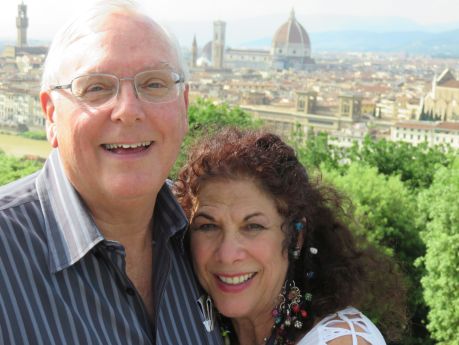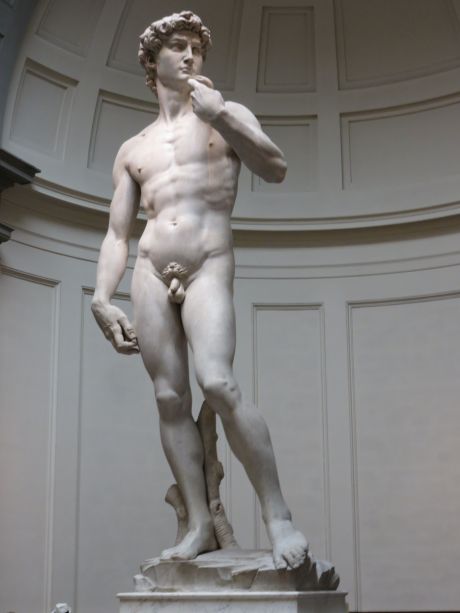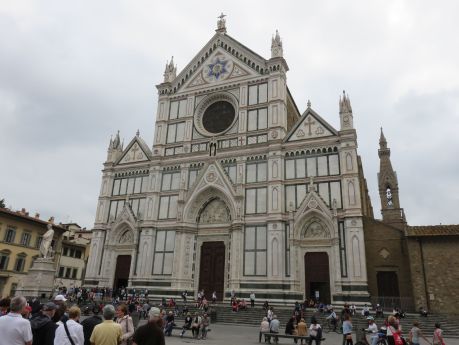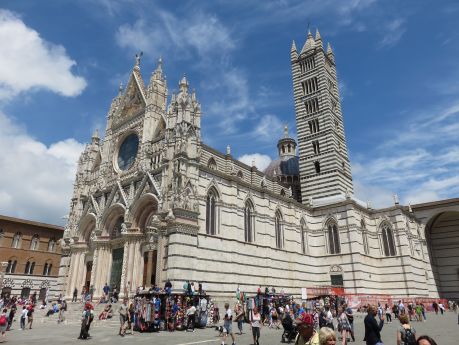Part 5: GONDALIERS DON’T SING AND NO ITALIAN WEDDING SOUP? A FIRST-TIMER’S DISCOVERY OF THE REAL ITALY.
THE CLASSICAL BEAUTY OF TUSCANY, THE ELEGANCE OF FLORENCE AND SAN GIMIGNANO’S TALL TOWERS
Part 4 was Medieval City Faced Chemical Warfare And Peace Makers Wage War Against Poverty In Orvieto And Assisi
SIENA, FLORENCE and SAN GIMIGNANO
Where we stayed:
Villa San Filippo is an 18th century 35-room resort in the Chianti hills, in Barberino Val D’Elsa. Russ and I stayed in a magnificent suite that opened up to a dining and kitchen area, tiled floors, and a step down to the bathroom and luxuriously appointed bedroom. A comfy chair positioned in front of a large window and balcony in the living room afforded spectacular views of the lush Tuscan landscape of vineyards and olive tree groves. The first evening we had a reception on an expansive decking overlooking the lush rolling hills that reflected the image I’ve always seen of Tuscany.
Where we dined and what we drank:
The first two nights of our Tuscany stay we ate at the Villa San Filippo. I wasn’t feeling well and the menu didn’t sit well with my stomach, so I tasted one bite and left. The main dish the first night was Al Cinghiace: tagliatelle with wild boar sauce. The next was Peposa, veal cooked in wine and spices. Dessert (I heard) was cantuccini con vin santo (white cookies).
Observation: because I had been feeling unwell from sinus and allergy issues, I ordered vegetable soup for many meals. It’s pretty much on every menu, although always prepared differently, from the chosen vegetables to the thickness of the broth. Rarely were there other options, and never did I see my favorite Italian Wedding Soup. Maybe no wedding = no soup, or was this like my idealized version of the Italian bread we have in the U.S; crunchy on the outside and softly yielding on the inside, perfect for spreading on butter or dipping in olive oil laced with herbs and garlic? Italian bread, especially in northern Italy, is a dry, unsalted, pretty tasteless roll that seems to have sat out for a week.
The first night reception at Villa San Filippo was our introduction to a Spritz, the signature drink of Venice that is now trendy across Italy. The one we had that night was a combo of prosecco, soda water and Aperol, an orange liquor made from a blend of spirit, rhubarb, chinchona, genziana and a secret combination of herbs. Other than a Spritz, I was surprised to learn that the #1 liquor in Italy is grappa, a grape-based pomace (skins, seeds and pits) brandy that contains 35 – 60% alcohol.
Our last night in the serenely pastoral Tuscany area we ate at Il Campanellino Osteria in Barberino Val d’Elsa. Maybe it was an omen of the good time to come because we happened to be there on the final night of the town’s flower festival and were followed up the short hill by the. Large Street Band (yes, that’s their name), rhythmically grooving and playing funky music in a marching band format. The service and culinary focus of the meal was excellent from start to finish. We began with a three-pecorino cheese course, each a different strength. They were served with fig, orange and apple jam, bread and salad. That was followed by crisp roasted potatoes and delicious steak filet with a balsamic vinegar glaze. The meal finished with the raspberry-drizzled sauce on a lava cake, the best I think I’ve ever had.
What we saw:
We made a side trip was to Florence. What we saw made us hunger for more. Another time we will return to focus on the art, food and museums. Florence is also known for leather, gold working, olive oil and wine. There are verdant green hills and stately Italian cypress trees dominating the landscape.
On this too-short visit, we briefly stopped twice (in the grey morning and later in the sunny dusk hours) to take in the panoramic views of the city from Piazzale Michelangelo, dedicated to the city’s most famous Renaissance artist, Michelangelo Buonarroti (1475-1565). At the center of the square is a bronze replica on a large pedestal of his most famous statue, David. This was our first up-close view of David, until we later visited the real deal in the Accademia Gallery in Florence. He was only 26 when he began and 29 when he finished David. He worked alone and without models or drawings, saying that the marble would talk to him and tell him where to sculpt.
Before getting to the 14’ high statue (the tallest freestanding statue of the time), in Accademia, we walked past his Four Prisoners, sculptures so named because Michelangelo said they still imprisoned inside the marble slabs. The Four Prisoners were never finished because Pope Julius II insisted Michelangelo do the Sistine Chapel (1533-37) ceiling, even though he was a sculptor and not a painter. Michelangelo was 89 when he died.
Many pieces of art have portrayed The Rape of the Sabine Women, an incident from 750 BC in which Roman men abducted women from neighboring Sabine families to take as wives. I walked around the three-dimensional sculpture by Flemish artist Gianbologna, marveling that he carved this fluidly emotive piece from a single block of stone. The Rape of the Sabine Women is considered the first example of a statue that could be viewed from any angle, not just a flat front or back. The word “rape” in the traditional Latin implies abduction, not sexual abuse.
St. Mary’s of the Flower Cathedral especially captured my husband Russ’ attention because of the sheer mechanics, vision, and follow-through it took for Fillippo Brunelleschi, considered to be the first modern engineer and planner, to create the Cathedral’s dome. The dome was the largest masonry dome ever built.
We first saw religious paintings by Sandro Botticelli, the official painter for the Medicis, in the Sistine Chapel, and now at St. Mary’s of the Flower we were able to see some of his works more closely.
I was also fascinated by the prominence of the Star of David on the top of Basilica di Santa Croce (Basilica of the Holy Cross). This Basilica, the largest Franciscan church in the world, is where Italian luminaries such as Michelangelo, Galileo, Machiavelli, and composer Rossini were buried. The Star of David was inserted into the neo-gothic façade by Jewish architect Niccolo Matas, who wanted to be buried with his peers. But because he was Jewish, he was instead buried under the threshold and honored with an inscription.
The Italians refer to the small walled medieval hill town of San Gimignano as Little Medieval Manhattan, with towers instead of skyscrapers. Located in the Siena province, San Gimignano, is famous for the preservation of their tower houses, built from the 12th century as a “mine-is-bigger-and-taller-than-yours mentality among nobles. Record books vary on the number of original towers, from 72 to 76, and depending on how they’re counted, there are now either 13 or 15 remaining of these Romanesque and gothic structures. This medieval town, a UNESCO World Heritage site, is so quaint and clean, it could be at an American theme park. San Gimignano is known for saffron, the Golden Ham, and its white wine, Vernaccia di San Gimignano, produced from the ancient variety of Vernaccia grapes that are grown on the sandstone hillsides.
We visited the Palagetto Winery, a family run business, for a delightful food and wine tasting. Originally the family produced olive oils before expanding to wine. They now have about 148 acres devoted to grapes and nearly 50 acres for olive trees. The Vernaccia is the strength of the white wines in this Tuscan area, and for which Palagetto wines are known. Chianti, Brunello di Montalcino and Vino Nobile di Montepulciano are primarily made with Sangiovese grapes.
Plates of local salami, pecorino cheese, pasta and Tuscan unsalted bread were paired with four of Palagetto’s wines. We were told the Vernaccia is aged in French oak, while their reds are aged in American oak. The first wine was 100% Vernaccia di San Gimignano, produced in 2012. Straw yellow with hint of green, several of us agreed it was a bit minerally with a salty finish. Our winery host said this wine would be best served with pasta, white meats, fish or medium aged cheeses. The second wine, an amber colored Vernacci 2014 Reserva that I found a bit smoother than the first, was aged 36 months. We were advised it would pair well with chicken or rabbit seasoned with saffron.
The next two wines were reds. The first, I’Terzo, is a chianti fermented in small cement tanks at a controlled temperature and then in the bottle for eight months. 14% alcohol. Could be served with pasta or steak. The fourth wine was Sottobosco, a blend of cabernet sauvignon, Syrah and Sangiovese. The host said it has become the winery’s most important and representative wine. A bit peppery with a long finish, the Sottobosco is aged three years in oak and then three years in the bottle.
What we learned:
One afternoon, we took a guided tour through the crowded sidewalks of Siena, passing through the rounded Piazza del Campo. We didn’t visit the Siena Duomo, but the 12th century Italian Romanesque–Gothic architecture is renowned.
The signature dessert exclusively of Siena is pan forte d”Siena, a small, intense cake made with honey, nuts and cinnamon sugar. Another Siena specialty is ricciarelli di Siena, marzipan meringue cookies coated in white icing or perhaps confectionary sugar.
Once the crossroads of international travel, Siena in the medieval ages had about 54,000 residents. They were powerful bankers to the Pope, which made Florence jealous. War ensued. Sienese appealed to the Virgin Mary for help. If they won, the whole city would be dedicated to her. They won. Bankers doing poorly at business gave rise to the term, “bankrupt.”
The residents may not be fighting Florence any longer, but the thrill of competition still gathers them twice a year for the Palio di Siena, a horse race in which each of the 17 contrada (districts of the city) race against one another. Each contrada is named for an animal or symbol. As you walk around the city, you see icons of the contrada atop doors or hanging from flag poles. Where you are born is your contrada unless you to take that of your husband or family member’s birthplace.
When Siena’s economy declined and taxes were paid based on the number and size of windows, residents decreased those entities in larger houses and turned them into apartments.
Next in Part 6 – GONDOLIERS DON’T SING BUT VENICE STILL EVOKES ROMANCE
www.villasanfilippo.com
www.galleriaaccademiafirenze.beniculturali.it
www.palagetto.it/
www.osteriailcampanellino.it
Karen Kuzsel is a writer-editor based in the Orlando area who specializes in the hospitality, entertainment, meetings & events industries. She is an active member of ILEA and MPI and is now serving on the 2017 – 2018 MPI Global Advisory Board for The Meeting Professional Magazine for the third consecutive year. She is a member of the Society of Professional Journalists. Karen writes about food & wine, spas, destinations, venues, meetings & events. A career journalist, she has owned magazines, written for newspapers, trade publications, radio and TV. As her alter-ego, Natasha, The Psychic Lady, she is a featured entertainer for corporate and social events. karenkuzsel@earthlink.net; www.ThePsychicLady.com; @karenkuzsel; @thepsychiclady.
Photos by Russ Wagner, a retired government planner/builder who has a passion for trains, travel and taking photographs.













Leave a Reply
Want to join the discussion?Feel free to contribute!